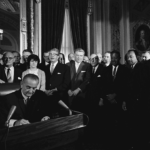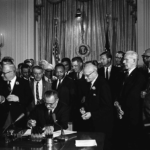In 1998, when Lilly Ledbetter filed her complaint of wage discrimination against the Goodyear Tire and Rubber Co. with the Equal Employment Opportunity Commission, her goal was to get equal pay for equal work because that was the law. She had no idea that her decision would eventually involve all three branches of government and result in a law with her name on it – the Lilly Ledbetter Fair Pay Act of 2009.
A Call to Act: Ledbetter v. Goodyear Tire and Rubber Co.
A Conversation on Ledbetter v. Goodyear Tire and Rubber Co.

Justice Stephen G. Breyer and a group of high school students discuss separation of powers among the three branches of government in connection with the pay discrimination case that resulted in a 2009 law – the Lilly Ledbetter Fair Pay Act. The video complements the documentary A Call to Act: Ledbetter v. Goodyear Tire and Rubber Co.
How a Bill Becomes a Law – Clean Water Act of 1972
The Federal Water Pollution Control Act, commonly known as the Clean Water Act, was originally passed in 1948. By 1972, Congress had voted on an amended version of the law that included the expansion of regulations to prevent pollution of the nation’s waterways. In this lesson, students consider how the Clean Water Act of 1972 became a law. They identify key moments in the evolution of this bill including its path in Congress, its veto by President Nixon and its eventual enactment. Preparing and organizing information, students interpret these key events and share them in a storyboard presentation. While intended for 8th grade students, the lesson can be adapted for other grade levels.
District of Columbia Compensated Emancipation Act of 1862
The 150th anniversary of the District of Columbia Compensated Emancipation Act of 1862
occurred in 2012. This bill was introduced to Congress to end slavery in the District of
Columbia. Many citizens and members of Congress alike noted that the legality of slavery in
the District of Columbia was inconsistent with the ideals and aspirations of the nation. Congress
approved the bill, and President Abraham Lincoln signed the act.
This activity features the District of Columbia Compensated Emancipation Act of 1862 and
other primary and secondary sources that tell the story of Congress’s role in this first major step
toward the freeing of enslaved African Americans. While intended for 8th grade students, the
lesson can be adapted for other grade levels.
Provide for the General Welfare – Interstate Highway and Defense Act
In the Constitution, Congress is charged with providing for the general welfare of the country’s
citizens. Historically, this has meant improving transportation, promoting agriculture
and industry, protecting health and the environment and seeking ways to solve social and
economic problems. In 1956, Congress passed the Federal-Aid Highway Act, popularly known as the National Interstate and Defense Highways Act, authorizing federal funding for the extension and
construction of a robust network of interstate highways. This project was one of the largest public
works in U.S. history establishing key transportation infrastructure that impacted lives of all
Americans — changing communities, access and economic possibilities and also providing key
routes for evacuating urban centers — a critical national defense issue in the Cold War era.
Analyzing primary source material, students discuss the origins and reasons for the National
Interstate and Defense Highways Act. Then, they work with historical and contemporary maps
as they consider the impact this important congressionally funded project. While intended for 8th
grade students, the lesson can be adapted for other grade levels.
Voting Rights Act of 1965: Lesson Plans & Resources

On August 6, 1965, President Lyndon B. Johnson signed the Voting Rights Act into law. This landmark piece of legislation made discrimination based on race illegal. This law protected the right to vote for all citizens; forced states to obey the Constitution; and reinforced the 15th Amendment. The Share My Lesson team has curated a collection of free lesson plans, activities, and classroom materials that educators can use to teach students about the Voting Rights Act.
Civil Rights
While the Reconstruction Amendments were an important step in ensuring equal rights for all people, regardless of race, racial injustices throughout the United States continued into the late 19th and 20th centuries, leading to the Civil Rights movement of the 1960s, and the passages of Supreme Court decisions and legislation, including Brown v. Board of Education, the Civil Rights Act of 1964, and the Voting Rights Act of 1965. Visit the National Constitution Center’s learning module to learn more about the freedom struggle and civil rights.
Competing Voices of the Civil Rights Movement
When most people think of the Civil Rights Movement in America, they think of Martin Luther King, Jr. delivering his “I Have a Dream” speech on the steps of the Lincoln Memorial in 1963 and receiving the Nobel Peace Prize the following year. But “the Movement” achieved its greatest results — the 1964 Civil Rights Act and the 1965 Voting Rights Act — due to the competing strategies and agendas of diverse individuals. Even black Americans, the primary beneficiaries of this landmark legislation, did not agree on the tactics that should be used to secure the equal protection of their rights. This unit presents the views of several important black leaders who shaped the debate over how to achieve freedom and equality in a nation that had long denied a portion of the American citizenry the full protection of their rights.
The 1964 Civil Rights Act: Lesson Plans and Resources

On July 2, 1964, President Lyndon B. Johnson signed the Civil Rights Act into law. Originally proposed by President Kennedy in 1963, this landmark piece of legislation made discrimination based on race, religion, sex or national origin illegal. Additionally, the Civil Rights Act ended the practice of unequal voter requirements based on race or sex and ended racial segregation in schools. The Share My Lesson team has curated a collection of free lesson plans, activities, and classroom materials for educators to use in teaching students about the Civil Rights Act.
